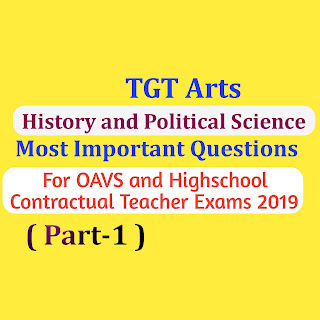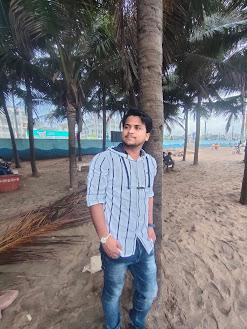History and Political Science Questions For OAVS and HighSchool Teacher Exams
 |
| OAVS and Highschool Teacher Exams |
A) Ahmadia Movement
B) Quit India Movement
C) Khilafat Movement..
D) Civil-Disobedience Movement
Answer : [C] Khilafat Movement(1919—1924) Also known as Indian Muslim Movement.
2. In which year did the Jallianwala Bagh
Massacre take place?
A) 1916
B) 1917
C) 1919..
D) 1913
13 April 1919 at Jallianwala bagh,
Amritsar, punjab
3. Swami Vivekananda found or launched the
Ramakrishna Mission in which year among the following?
A) 1893
B) 1897..
C) 1899
D) 1896
4. The Indian National Army (INA) was
originally founded by :
A) Rash Bihari Bose
B) Subhas Chandra Bose
C) Captain Mohan Singh..
D) Vallabhbhai Patel
5. Who founded the Widow Remarriage
Association in 1850s?
A) Raja Ram Mohan Roy
B) Iswar Chandra Vidyasagar
C) Swami Dayananda Saraswati
D) Vishnu Shastri Pandit..
6. Which form of Government has been accepted
by the Indian Constitution?
A) Presidential
B) Dictatorial
C) Monarchy
7. What was the name of the social reformer of
India who started Prarthana Samaj?
A) Raja Ram Mohan Roy
B) Swami Dayananad Saraswati
C) Atmaram Pandurang..
D) Ishwar Chandra Vidyasagar
8. According to Indian Constitution, which of
the following is INCORRECT under Right to Freedom ?
A) Form associations or unions
B) Freedom of speech and expression
C) Move freely throughout the
territory of India
D) Assemble peaceably and with arms..
9. Which of the following was the first phase
of the Indian National Congress from the year 1885 to 1903?
A) Revolutionary Nationalism
B) Extremism
C) Gandhian Era
D) Moderate Nationalism..
10. According to the rules of the Indian
Parliament, a Money bill should be introduced by
A) President
B) Finance Ministry
C) Lok Sabha..
D) Rajya Sabha
11. Who among the following freedom fighters
was the first woman Governor of Uttar Pradesh in Independent India and also
wrote a famous book known as “The Golden Threshold”?
A) Sucheta Kriplani
B) Aruna Asaf Ali
C) Sarojini Naidu..
D) Vijay Lakshmi Pandit
12. Under which Article the Right to Freedom
is mentioned in the Constitution of India?
A) Article 24
B) Article 19..
C) Article 28
D) Article 14
13. Which of the following is regarded as the
guardian and the protector of people's Fundamental Rights in India?
A) Comptroller and Auditor General of
India
B) Only the Parliament of India
C) The Supreme Court of India..
D) Only Executive Council
14. Which Amendment removed the Right to
Property as one of the Fundamental Rights of Indian Constitution?
A) 40th Amendment
B) 44th Amendment..
C) 46th Amendment
D) 42nd Amendment
15. Which was the first newspaper published in
the year 1816 in India?
A) Calcutta Gazette
B) Bengal Gazette..
C) Bombay Gazette
D) Madras Pioneer
16. Under which Jurisdiction, Supreme Court
can review the decisions of High Court?
A) Appellate Jurisdiction..
B) Original Jurisdiction
C) Emergency Jurisdiction
D) Special Jurisdiction
17. Who was elected as the permanent President
of the Constituent Assembly of India after its first meeting in the year 1947?
A) Dr B. R. Ambedkar
B) Jawahar Lal Nehru
C) Mahatma Gandhi
D) Dr. Rajendra Prasad..
18. In which year did Raja Ram Mohan Roy
establish the Brahmo Samaj?
A) 1828..
B) 1823
C) 1882
D) 1832
19. Which branch of the Indian Government in
the Indian Democracy is responsible for executing and implementing policies?
A) Indian Media
B) Judiciary
C) Legislature
D) Executive..
20. After the First War of Independence, the
last Mughal emperor Bahadur Shah II (Bahadur Shah Zafar) was exiled by British
and sent to which place among the following?
A) Mandalay
B) Andaman and Nicobar Islands
C) Hyderabad
D) Rangoon..
21. Who started the Non-Cooperation Movement
in India against the British?
A) Motilal Nehru
B) Dr B. R. Ambedkar
C) Lala Lajpat Rai
D) Mahatma Gandhi..
22. Who among the following were the first to
establish regular trade with India?
A) Portuguese..
B) Dutch
C) English
D) French
23. The first Indian Women University was set
up in 1916 at Bombay (Mumbai) by
A) Swami Dayananda Saraswati
B) Sir Sayed Ahmad Khan
C) Mahadev Govind Ranade
D) Dr. Dhondo Keshav Karve..
24. Who was the British Governor-General who
introduced the Subsidiary Alliance in India?
A) Warren Hastings
B) Lord Curzon
C) Lord Wellesley..
D) Lord Cornwallis
25. The first Indian ruler who joined the
subsidiary Alliance was:
A) The Nizam of Hyderabad..
B) Peshwa Baji Rao II
C) The Nizam of Bengal
D) The Nawab of Oudh
26. Who was the chairman of the Drafting
Committee for the Constitution of the Constituent Assembly of India?
A) Bipin Chandra Pal
B) Dr. Rajendra Prasad
C) Pt. Jawaharlal Nehru
D) Dr. B. R. Ambedkar..
27. Which Indian religious leader gave the
call ‘Back to the Vedas’?
A) Raja Ram Mohan Roy
B) Swami Vivekananda
C) Mahatma Jyotiba Phule
D) Swami Dayanand Saraswati..
28. Which among the following societies was
introduced by Raja Ram Mohan Roy?
i) Arya Samaj
ii) Brahmo Samaj
iii) Prarthana Samaj
A) Only i
B) All i, ii, iii
C) Only ii..
D) Only iii
29. Which of the following is a policy that
was introduced by Lord Wellesley to have the British supreme power in India?
A) Doctrine of Lapse
B) Divide and Rule
C) Slavery system
D) Subsidiary Alliances..
30. The Asiatic Society was established in the
year 1784 by
A) Lord Bentinck
B) Charles Cornwallis
C) Sir William Jones..
D) Warren Hastings
31. Who was the founder of Indian National
Congress?
A) Annie Beasant
B) Jawaharlal Nehru
C) Mahatma Gandhi
D) Allan Octavian Hume..
32. How many Articles were there in Indian
Constitution, at the time of the commencement?
A) 390
B) 392
C) 395..
D) 393
33. Which article of Indian Constitution
grants the establishment of Supreme Court?
A) 128
B) 127
C) 124..
D) 126
34. Under which Article the Right to Freedom
is mentioned in the Constitution of India?
A) Article 28
B) Article 14
C) Article 24
D) Article 19..
35. Members of the Lok Sabha in the Parliament
of India are elected for how many years?
A) 3
B) 5..
C) 4
D) 2
36. The Indian National Congress was founded
in the year 1885 by a retired British civilian named
A) Allen Octavian Hume..
B) Lord Ripon
C) John Watts
D) Warren Hastings
37. Who is the founder of Young Bengal
Movement?
A) David Hare
B) Aurobindo Ghosh
C) Swami Vivekananda
D) Henry Vivian Derozio..
38. Who introduced the ‘Civil Services’ in
India?
A) Lord Wellesley
B) Lord Cornwallis..
C) Lord Curzon
D) Lord Dalhousie
39. How many Freedoms have been assigned to
Indian Citizens through the Right to Freedom under Fundamental Rights of the
Indian Constitution?
A) 7
B) 4
C) 6
D) 5..
40. First World War started in which year
among the following?
A) 1913
B) 1919
C) 1914..
D) 1916
41. Which social evil was the chief concern of
Ishwar Chandra Vidyasagar?
A) Purdah System
B) Child Marriage
C) Sati System
D) Widow-Remarriage..
42. How many houses are there in the
Parliament of India?
A) 2..
B) 1
C) 3
D) 4
43. How many Fundamental Rights have been
given to the people of India by the Indian Constitution?
A) 6..
B) 8
C) 5
D) 7
1)Right to equality 2) Right to
Freedom 3) Right against exploitation 4) Right to freedom of religion 5)
Cultural and educational right 7) Right to constitutional remedies
44. Who among the following rulers is
considered as the first independent Nawab of Bengal who also had issued a coin
named Zurbe Murshidabad?
A) Shuja-ud-Din Muhammad Khan
B) Mir Qasim
C) Murshid Quli Khan..
D) Mir Jafar
45. Who among the following was the founder of
Prarthana Samaj in India?
A) Swami Dayananda Saraswati
B) Atmaram Pandurang..
C) Iswar Chandra Vidyasagar
D) Ramakrishna Paramahamsa
46. Which British Governor-General proposed
for the abolishment of the Pilgrimage Tax?
A) Lord Auckland..
B) Lord Elgin
C) Lord Hastings
D) Lord Ellenborough
47. In which year among the following the
Second World War broke out?
A) 1945
B) 1935
C) 1930
D) 1939..
48) Into how many estates or classes was the French society
divided during the time of French Revolution?
A) 2
B) 3..
C) 4
D) 5
49) The Japanese forces attacked the Pearl Harbour of United
States of America on
A)
December 8, 1940
B)
December 7, 1941..
C)
December 11, 1945
D) December 7, 1942
50) Which regulations made English as a medium of education
compulsory in government-aided schools and colleges during the British Era?
A) Pitts
India Act, 1784
B)
Regulating Act, 1773
C)
Macaulay’s Minutes, 1835..
D) Educational Despatch, 1854
51)Who among the following wrote a book originally in Hindi known
as 'Satyarth Prakash'('The Light of Meaning of the Truth')?
A) Ishwar
Chandra Vidyasagar
B) Swami
Vivekananda
C) Swami
Dayanand Saraswati..
D) Raja Ram Mohan Roy
52) Who campaigned for widow remarriage and succeeded in getting
widow remarriage act passed in the year 1856?
A) Raja
Ram Mohan Roy
B) Swami
Dayananda Saraswati
C) Ishwar
Chandra Vidyasagar..
D) Mahatma Jyotiba Phule
53) The name of the Germany’s plan for attacking France and Russia
during World War I was known as
A) Sturm
und Drang
B) The Hindenburg
Plan
C)
Operation Barbarossa
D) The Schlieffen Plan..
54)Who among the following composed the song ‘Vande Matharam’?
A) Madam
Cama
B) Bankim
Chandra Chatterji..
C)
Rabindranath Tagore
D) Satyjit Ray
55) Which of the following is a policy that was introduced by Lord
Wellesley to have the British supreme power in India?
A)
Doctrine of Lapse
B) Divide
and Rule
C) Slavery
system
D) Subsidiary Alliances..
56) In the year 1908, who was hanged for making an attempt to kill
the unpopular Judge Kingsford at Muzaffarpur?
A)
Aurobindo Ghosh
B)
Prafulla Chaki
C) Ashwini
Kumar Dutta
D) Khudiram Bose..
57) Who among the following wrote the famous book called "The
Social Contract"?
A)
Jean-Jacques Rousseau..
B) Charles
de Montesquieu
C) Denis
Diderot
D) Voltaire
58) By which of the following Acts, the Governor General of Bengal
became the Governor General of British India?
A) The
Charter Act of 1853
B) The
Regulating Act of 1773
C) The
Charter Act of 1813
D) The Charter Act of 1833..
More Questions Will Coming Soon....Stay tuned Us....








No comments:
Post a Comment